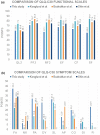Health-related quality of life and clinical outcome after radiotherapy of patients with intracranial meningioma
- PMID: 36396802
- PMCID: PMC9672325
- DOI: 10.1038/s41598-022-24192-8
Health-related quality of life and clinical outcome after radiotherapy of patients with intracranial meningioma
Abstract
This retrospective, single-institutional study investigated long-term outcome, toxicity and health-related quality of life (HRQoL) in meningioma patients after radiotherapy. We analyzed the data of 119 patients who received radiotherapy at our department from 1997 to 2014 for intracranial WHO grade I-III meningioma. Fractionated stereotactic radiotherapy (FSRT), intensity modulated radiotherapy (IMRT) or radiosurgery radiation was applied. The EORTC QLQ-C30 and QLQ-BN20 questionnaires were completed for assessment of HRQoL. Overall survival (OS) for the entire study group was 89.6% at 5 years and 75.9% at 10 years. Local control (LC) at 5 and 10 years was 82.4% and 73.4%, respectively. Local recurrence was observed in 22 patients (18.5%). Higher grade acute and chronic toxicities were observed in seven patients (5.9%) and five patients (4.2%), respectively. Global health status was rated with a mean of 59.9 points (SD 22.3) on QLQ-C30. In conclusion, radiotherapy resulted in very good long-term survival and tumor control rates with low rates of severe toxicities but with a deterioration of long-term HRQoL.
© 2022. The Author(s).
Conflict of interest statement
The authors declare no competing interests.
Figures


References
-
- Kleihues P, Cavenee WK. Pathology and Genetics of Tumours of the Nervous System. International Agency for Research on Cancer; 2000.
Publication types
MeSH terms
LinkOut - more resources
Full Text Sources

